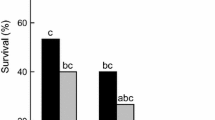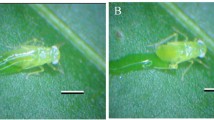Abstract
Factors influencing water loss inPeriplaneta americana (L.) treated with vapours of some selected fumigants have been investigated. Ventilation of fumigated roaches does not control transpiration. The enhanced duration of opening of the spiracles causes an increased water loss in the fumigated insects. Water loss is also dependent upon the molecular weights of the compounds in a chemical series.
Similar content being viewed by others
References
Gunn, D. L., The temperature and humidity relations of the cockroach (Blatta orientalis). I Desiccation.J. Exp. Biol. 10 274–285 (1933).
Mellanby, K., The site of loss of water from insects.Proc. R. Soc. London B 116 139–149 (1934).
Mellanby, K., The evaporation of water from insects.Biol. Rev. 10 317–333 (1935).
Ramsay, J. A., Methods of measuring the evaporation of water from animals.J. Exp. Biol. 12 355–372 (1935a).
Ramsay, J. A., The evaporation of water from the cockroach.J. Exp. Biol. 12 373–383 (1935b).
Bursell, E., Spiracular control of water loss in the tsetse fly.Proc. R. ent. Soc. London A 32 21–29 (1957).
Bursell, E., The water balance of tsetse flies.Trans. R. ent. Soc. London 111 205–235 (1959).
Bursell, E., Environmental aspects: Humidity, inThe Physiology of Insecta (ed. M. Rockstein) Vol. I pp. 323–361 New York, Academic Press (1964)..
Miller, P. L., Factors altering spiracle control in adult dragonflies: Water balance.J. Exp. Biol. 41 331–342 (1964).
Loveridge, J. P., The control of water loss inLocusta migratoria migratorioides R. and F. II. Water loss through the spiracles.J. Exp. Biol. 49 15–29 (1968b).
Wigglesworth, V. B., Permeability of insect cuticle.Nature London 147 116 (1941).
Wigglesworth, V. B., Action of inert dusts on insects.Nature London 153 493–494 (1944a).
Wigglesworth, V. B., Abrasion of soil insects.Nature London 154 333–334 (1944b).
Wigglesworth, V. B., Transpiration through the cuticle of insects.J. Exp. Biol. 21 97–114 (1945).
Alexander, P., Kitchener, J. A. and Briscoe, H. V. A., Inert dust insecticides. I–III.Ann. Appl. Biol. 31 143–159 (1944).
Parkin, E. A., Control of granary weevil with finely ground mineral dusts.Ann. Appl. Biol. 31 84–88 (1944).
Beament, J. W. L., The cuticular lipoids of insects.J. Exp. Biol. 21 115–131 (1945).
Ebeling, W., The permeability of insect cuticle, inThe Physiology of Insecta (ed. M. Rockstein., Vol. III pp. 507–556. New York: Academic Press (1964).
Loveridge, J. P., The control of water loss inLocusta migratoria migratorioides R. and F. I. Cuticular water lossJ. Exp. Biol. 49 1–13 (1968a).
Wagner, R. E., Ebeling, W. and Clark, W. R., An electric barrier for confining cockroachs in large rearing or field collecting cans.J. Econ. Ent. 57 1007–1009 (1964).
Mehrotra, O. M., Parti, S. L. and Agarwal, P. N., A laboratory technique of culturing cockroaches.Indian J. Ent. 27 358–360 (1965).
Bhatia, S. S., An integrated technique to study the effects of fumigants on respiration of insects.J. stored Prod. Res. 5 57–67 (1969).
Tonapi, G. T., The effects of fumigants on the physiology of respiration inPeriplaneta americana L.Proc. Indian Acad. Sci. B 73 209–220 (1971).
Miller, P. L., Respiration in the desert locust. I–III.J. Exp. Biol. 37 224–278 (1960).
Roeder, K. D.,Insect Physiology. 1100 pp. New York: John Wiley and Sons (1953).
Kitchel, R. L. and Hoskias, W. M., Respiratory ventilation in the cockroach in air, in carbon dioxide and nicotine atmospheres.J. Econ. Ent. 28 924–933 (1935).
Davies, M. E. and Edney, E. B., The evaporation of water from spiders.J. Exp. Biol. 29 571–582 (1952).
Dethier, V. G., Chemoreception, inInsect Physiology (ed. K. D. Roeder). pp. 544–576. New York, John Wiley and Sons (1953).
Dethier, V. G.,The Physiology of Insect Senses. 226 pp. London, Methuen and Co. Ltd. (1963).
Glover, L. H. and Richardson, C. H., The penetration of gaseous pyridine, piperidine and nicotine into the body of the American cockroach,Periplaneta americana L.Iowa State Coll. J. Sci. 10 249–260 (1936).
Brown, A. W. A.,Insect Control by Chemicals. 817 pp. New York, John Wiley and Sons (1951).
Bhatia, S. S. and Tonapi, G. T., Effects of fumigants on the spiracles and the possible role of neurohumor on the spiracular activity ofPeriplaneta americana L.Experientia 24 1224–1225 (1968).
Ingram, R. L., Water loss from the insects treated with pyrethrum.Ann. Ent. Soc. Am. 48 481–485 (1955).
Author information
Authors and Affiliations
Additional information
Communicated by Prof. T. S. Mahabale,f.a.sc.
Rights and permissions
About this article
Cite this article
Bhatia, S.S. Effects of fumigants on the water loss inPeriplaneta americana (L.). Proc. Indian Acad. Sci. 83, 18–25 (1976). https://doi.org/10.1007/BF03045470
Received:
Revised:
Issue Date:
DOI: https://doi.org/10.1007/BF03045470




